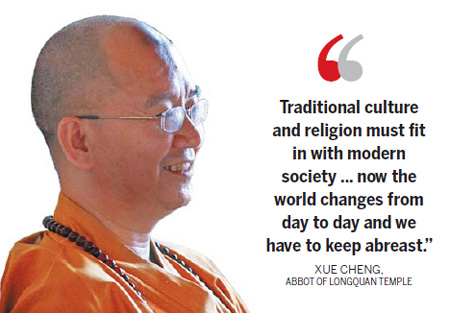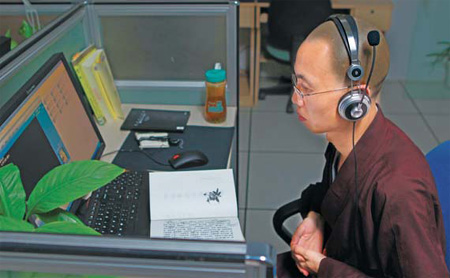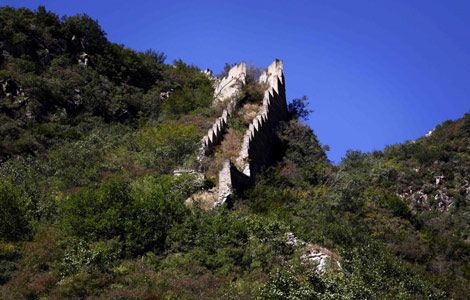The Modern Monks of China
Updated: 2011-07-17 07:52
By Tang Yue (China Daily)
|
|||||||||||
|
A young monk contemplates a wall of the gilded images of Buddha in the main hall of the Longquan Temple in Beijing's Haidian district. Cui meng / China Daily |


The world-weary have sought refuge in Buddhist temples for thousands of years, shedding their earthly entanglements for a higher calling. But what about now? Tang Yue goes into retreat to fi nd out more about the Buddhist monks of 21st-century China.
Buddhism in China is about 2,000 years old. It has had a roller-coaster history with its popularity reaching a peak during the Tang Dynasty (AD 618-907). It was during this period that Xuan Zang, its most ardent advocate and arguably China's most famous monk, traveled overland to India in search of original Buddhist scriptures. His journey took 17 years, and it became the stuff of legends, including the inspiration for Wu Cheng'en's novel Journey to the West, an allegory spiced up with the fictional disciples Monkey, Piggy and Sharky, a sort of China's equivalent to John Bunyan's Pilgrim's Progress. As New China hurtled into socialism, religion took a backseat as revolutionary fervor became the faith of the day. China was changing and it had other priorities. Fast-forward again to the 2010s, and today's Buddhist leaders are looking at a revival. As life gets more comfortable, and urban pressures increase, the resulting paradox has stirred up spiritual needs. But 14 centuries after Buddhism set root in China, it is a very different scenario. There are now new platforms from which to evangelize and preach. While the monks of yore had to trudge far to spread Buddhist teachings, the modern missionaries are able to communicate with a click of the mouse. There are online sermons, and many religious leaders make use of that very useful networking tool - the microblogs. Sometimes, they even blog in many languages.
We got a first-hand look at how it works at Beijing's Longquan Temple in Fenghuangling, a Buddhist sanctuary built in the Liao Dynasty more than 1,000 years ago.
Like many monasteries all over the country, it has withstood the tribulations of history. The latest was during the turbulence of the "cultural revolution", when it became a silent shell.
In 2004, Abbot Xue Cheng began restoring the ancient temple, with the help of a few disciples.
Since then, more than 100 young men, many of them graduates from the most prestigious Chinese universities, have been tonsured here.
One of them, Chan Xing, has a doctorate in fluid dynamics from Tsinghua University. He was one of those who followed the abbot here from Fujian province six years ago, and he recalls those early days.
"There were only three bungalows here, with no heating system. The winters were really torturous," he remembers.
Now, there is a fully heated multi-story dormitory, a library, computer room and laundry room - "just like a campus". There is even a garbage recycling system.
"You can see the construction site over there. I don't think we will stop building in the next 10 years because the number of residents keeps growing," Chan Xing says as he leads us to the work-site on a sunny afternoon.
Physical comforts aside, Buddhist lessons for the novices are also very different from the darker ages.
To make lessons relevant, movies like The Matrix, The Ice Age, and Kungfu Panda are incorporated into the lectures.
"Traditional culture and religion must fit in with modern society. Life in ancient times was very simple and static, now the world changes from day to day and we have to keep abreast," says Abbot Xue Cheng, who is also the vice-president of the Buddhist Association of China.
The 44-year-old abbot started a blog in 2006 and it has already logged almost 7 million page views.
His microblog is translated into seven languages - English, Japanese, Korean, Russian, French, Spanish and German - thanks to volunteers.
On the temple's website are streamed videos of Buddhism lectures, and a recently launched interactive program.
Offline, the temple welcomes those who are interested in Buddhism to learn more about the religion at the temple. College students, white-collar workers and even the Party School of the CPC Central Committee have all signed the guest-book.
The monks at Longquan bring their beliefs into daily life.
They have set up a foundation for charity, where believers and volunteers can join in activities that include distributing free porridge and a kind greeting to office workers in the CBD who are too busy to have breakfast, such as the harried passengers at the Beijing West Railway Station.
"As the quality of material life improves in China, the people's need for a more fulfilled spiritual life rises, and more and more people are interested in Buddhism," says Xian Jian, 38, who used to teach economics in Henan University.
"If you see it from the perspective of satisfying the market, we are just trying to expand the channels and meet the demands of 'potential customers," he says, betraying his secular education.
But the consequences of pop culture, the runaway pace of life and temptations from advanced communication channels worry the abbot.
So it is that only senior monks are trusted to keep updated online, while novices are not allowed to have cell phones or to browse content on the Internet not related to Buddhism.
"Too much information will distract the monks, especially the young ones," according to the abbot.
This rule can be hard for novices from the IT age, like Xian Xun. He was a fan of the LA Lakers and the Houston Rockets, and he used to watch a lot of NBA games in college.
When he first came to the temple last summer, he couldn't help but log on to the sports news when he was online.
"It still comes to mind, but I don't do it anymore," he says. Online pornography is a challenge as well, and despite firewalls and blocks, the cheeky content can still pop up unexpectedly. These temptations justify the abbot's strict rules of no Internet.
There is yet another, unexpected, hurdle for the abbot at Longquan Temple - the question of money and profitability.
Unlike his famous counterpart at Shaolin Temple, Abbot Xue Cheng has chosen to keep business outside his temple gate.
Visitors are not charged admission, and even the joss sticks for devotees at the temple are free of charge.
None of the monks are paid an allowance for fear that "salary leads to inequality".
"The gap between the rich and poor has been the root of social problems the world over. No money, no distractions," the abbot says.
"Now some temples are doing business. The function and space of the temple is severely impacted. It is for us to keep the integrity of the temple."
You can contact the writer at tangyue@chinadaily.com.cn.
|
Monks in the IT age use the Internet to share lessons and also to spread Buddhist teachings through multilingual microblogs. Cui Meng / China Daily |
(China Daily 07/17/2011 page1)













